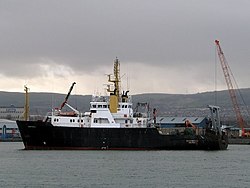Corystes (ship)
|
Corystes in Belfast
|
||||||||||||||||||
|
||||||||||||||||||
|
||||||||||||||||||
|
||||||||||||||||||
|
||||||||||||||||||
|
||||||||||||||||||
The Corystes is a British research ship . It is used primarily by the Agri-Food and Biosciences Institute in Belfast in the Northern Irish coastal waters and the Irish Sea for fisheries and marine research . The ship is managed by Heyn Engineering. The ship stationed in Belfast is named after the masked crab ( Corystes cassivelaunus ).
history
The ship was built in 1988 at Ferguson Ailsa shipyard in Troon , Scotland , for the Center for Environment, Fisheries and Aquaculture Science (CEFAS). On January 31, 2005, it went to the Department of Agriculture and Rural Development for Northern Island (DARD) and replaced the older research ship Lough Foyle .
Technical data and equipment
The ship is powered by diesel-electric technology . Two generators are available for the power supply of the drive motors, which are driven by two Allen S12 diesel engines with a total output of 2,000 kW . Additional generator sets supply the on-board network. The drive motors act on a propeller with a Becker rudder. The ship is equipped with a propeller nacelle as a transverse thrust control system, which is driven by a 450 kW motor. The ship meets the requirements of the International Council for the Exploration of the Sea with regard to the emission of underwater noise (ICES 209).
For research, the ship has u. a. several echo sounders and sonar systems as well as winches for trawling and various devices. It can also be used to survey the sea floor . The ship has two moon pools and is equipped for the use of ROV .
At the stern of the ship there is a swiveling stern boom with 7 t (SWL) lifting capacity. Another swiveling lifting tool with 2 t (SWL) capacity is located on the starboard side. In addition, the ship is equipped with three working cranes, each of which can lift 1 t. Two of the cranes are in the stern area, one in the fore ship area. Another crane is used to launch and haul in the workboat , which is carried on the front superstructure of the ship.
Several laboratory and control rooms are set up for research. The open work area in the aft area is 250 m². A 20-foot container can be stowed on deck .
There is space on board for 16 crew members and 11 scientists. Nine cabins are available for the scientists.
The ship can stay at sea for up to 20 days, covering up to 9,000 nautical miles .
Web links
- Data sheet , Agri-Food and Biosciences Institute (PDF file, 340 kB)
- Brochure , Agri-Food and Biosciences Institute (PDF file, 1.3 MB)
- Side view of the ship , Agri-Food and Biosciences Institute (PDF file, 2.3 MB)
Individual evidence
- ^ A b c Research Vessel Corystes , Agri-Food and Biosciences Institute. Retrieved November 22, 2017.
- ↑ Research Vessel Corystes , Heyn Engineering. Retrieved November 22, 2017.
- ↑ Linda McKee: Ulster's climate apocalypse , Belfast Telegraph, December 6, 2006. Retrieved November 22, 2017.
- ↑ a b RV Corystes Specification ( Memento of March 5, 2012 in the Internet Archive ), Agri-Food and Biosciences Institute (PDF file, 90 kB).
